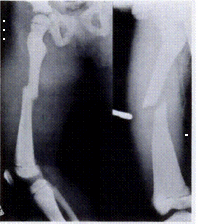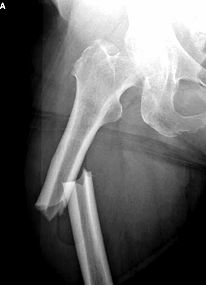 Fosamax, Actonel, Osteoporosis and Toulouse Lautrec
Fosamax, Actonel, Osteoporosis and Toulouse Lautrec by Jeffrey Dach M.D.
Viewing Osteoporotic Compression Fractures All Day
While working as a radiologist for 25 years, a large part of my day was spent reading X-rays of osteoporotic compression fractures of the spine, which was quite common. These fractures typically involve the mid thoracic spine causing loss of height and curvature of the spine, and considerable pain.
Above Image: The modiste Mademoiselle Margouin Year 1900 by Henri Toulouse Lautrec, Musée Toulouse-Lautrec. Image Courtesy of Wikipedia
Vertebroplasty for Compression Fracture - Barbaric?
Working in the hospital over the years, I saw many procedures come and go. A procedure called vertebroplasty, still in vogue, is used for treatment of compression fractures. This involves injecting glue into the collapsed vertebral body under X-Ray control.(1)
Vertebroplasty Procedure Discredited
In 2009, two studies showed Vertebroplasty had no merit, producing results no better than a sham operation. The authors concluded the procedure was without merit and should be abandoned. The medical community ignored these studies, and numbers of procedures actually increased.(16-18)
Prevention Makes More Sense
On the surface, it might appear callous for the medical system to wait years until thousands of women develop severe osteoporosis with compression fractures, and then intervene with glue injections. Perhaps some form of prevention would make more sense. The usual preventive recommendation to take calcium tablets apparently was not effective for these women presenting with osteoporotic compression fractures. Perhaps the best preventive plan can be found in Russell Jaffe’s article, Acid-Alkaline Balance and its Effect on Bone Health.(3) Russell Jaffe MD is a charming and humorous fellow who informed our small group of docs at his medical seminar that in the old days he ran a lab at the NIH, and was actually offered the job of Assistant Surgeon General, but he declined the offer after trying it for a day. He is also the founder of a supplement company called Perque.(15)
Bisphosphonate Drugs and Toulouse Lautrec's Genetic Bone Disease
For the impatient ones who wish to see a prompt increase in bone density, the FDA approved the bisphosphonate drug Fosamax (alondronate) which was first introduced in 1995. Merck made 3.2 Billion on 22 million Fosamax prescriptions in 2006. A major drug study, (FIT) the Fracture Intervention Trial, showed lower fracture rates in the drug group.(4) And it is true that the bisphosphonate drugs will reward the user with a prompt increase in bone density. The main question remains however, how strong is the bone with the increased density? This is an important question because we know from studies of Toulouse Lautrec that his increased bone density was not stronger, in fact his bones were much weaker leading to spontaneous fracture and jaw necrosis. This is explained below.


Image Above: Henri Toulouse Lautrec courtesy of wikipedia,
short stature from pycnodysostosis.
Genetic Bone Disease Duplicates Action of Fosamax
What could fosamax (alondronate) have in common with Toulouse Lautrec, the famous French Impressionist artist? One day, Toulouse Lautrec's name came up in conversation, and we puzzled over the cause of Lautrec's short stature. After looking up the question on the internet, we discovered that Toulouse Lautrec’s parents were first cousins giving Toulouse the autosomal recessive genetic disease, pycnodysostosis, which means dense bones. I had seen X-Rays of this bone disease in text books while studying for the radiology board exams, but I have never seen it in actual practice.
Dr. Gelb found Toulouse Lautrec's dense bone disease was caused by a genetic defect in cathepsin K, a protease enzyme of the osteoclast cells responsible for removing and remodeling bone.(5)(6) Osteoclast cells are bone cells involved in resorption and remodeling of bone. In this disease, the genetically abnormal bone is very dense on xrays, and yet looking under microscopic examination, one sees profound deterioration in trabecular architecture and lamellar arrangement. This is presumably the reason for spontaneous fracture and jaw necrosis which occurs in Lautrec's genetic bone disease, and also occurs as an adverse side effect of the bisphosphonate drugs.(7)
 This osteoclast dysfunction and resulting bone fragility explains why Toulouse had spontaneous fractures of both mid femurs at the age of 12 and 14. The mid-femur fractures never healed properly. The non-healing mid femur fractures caused Toulouse Lautrec to have short stature, attaining a final height of only four and a half feet.(8)
This osteoclast dysfunction and resulting bone fragility explains why Toulouse had spontaneous fractures of both mid femurs at the age of 12 and 14. The mid-femur fractures never healed properly. The non-healing mid femur fractures caused Toulouse Lautrec to have short stature, attaining a final height of only four and a half feet.(8) Left Image: Spontaneous fracture of mid femur in child with pycnodysostosis. Courtesy of Taylor et al. J Bone Joint Surg Am 60 (8): 1128.
Bisphosphonate Mechanism of Action - Same as Lautrec's Defect
Bisphosphonate drugs (fosamax and actonel) are taken up by osteoclasts, causing disruption of osteoclast activity. The osteoclasts are bone cells involved in bone resorption and remodeling. This loss of the osteoclast activity inhibits bone resorption and bone remodeling, tasks otherwise performed by the osteoclasts.(9) Thus, the bisphosphonate drugs produce a chemical disruption of osteoclast activity same as the genetic disease of Toulouse Lautrec. The bisphosphonate drugs also produce the same adverse side effects, namely jaw necrosis and spontaneous fracture.
Questions About Long Term Safety of Bisphosphonates
The conventional medical test for bone density is the DEXA bone scan. And, indeed DEXA bone scanning does confirm that bisphoshonate drug treatment increases bone density, and studies such as the FIT (Fracture Intervention Trial) report drug treatments reduce fracture rates in severly osteoporotic women over the short term. However, Susan Ott, MD raises questions about the long term safety of bisphosphonates.(10) Although the bisphosphonate drugs appear to have short term benefits, Dr. Susan Ott speculates that over the long term, after 5 years of use, the drugs cause severe suppression of bone formation, and negative effects such as microdamage and brittleness.
Reports of Spontaneous Fractures
 Jennifer P. Schneider, MD, PhD reports a 59-year old previously healthy woman on long-term alendronate.(11) While on a subway train in New York City one morning, the train jolted, and the woman shifted all her weight to one leg, felt a bone snap, and fell to the floor, suffering a spontaneous mid -femur fracture (see right image). In the months following, it became clear that the fracture was not uniting.
Jennifer P. Schneider, MD, PhD reports a 59-year old previously healthy woman on long-term alendronate.(11) While on a subway train in New York City one morning, the train jolted, and the woman shifted all her weight to one leg, felt a bone snap, and fell to the floor, suffering a spontaneous mid -femur fracture (see right image). In the months following, it became clear that the fracture was not uniting.Right Image: Spontaneous mid femur fracture courtesy of Jennifer P. Schneider, MD, PhD January 2006 Volume 61, Number 1 Geriatrics
Schneider speculates that increased bone density from the bisphosphonate drug does not necessarily equate with good bone quality. By decreasing osteoclast activity and bone resorption, and therefore bone formation as well, microdamage, and brittle bone may result in fractures.(11)
Odvina reports on a series of 9 patients who suffered spontanous fracture while on fosamax (alendonate). Five of the nine cases were spontaneous mid femur fractures.(12) Two had bilateral mid femur fractures just like those sustained by Toulouse Lautrec. Six of the fractures showed delayed or absent fracture healing. Histomorphometric analysis of the cancellous bone showed markedly suppressed bone formation, and Odvina raised the possibility that severe suppression of bone turnover could develop during long-term fosamax (alendronate) therapy, resulting in increased susceptibility and delayed healing of fractures.
Dimitrakopoulos report on 11 patients presenting with necrosis of the jaw, claiming this to be a new complication of bisphosphonate therapy administration, i.e. osteonecrosis of jaws.(13) He advised clinicians to reconsider the merits of the rampant use of bisphosphonates. Osteonecrosis of the jaw is a common finding in pycnodysostosis. The bisphosphonates recreate the same clinical profile of spontaneous mid femur fractures, failure of bone healing and jaw necrosis which tormented Toulouse Lautrec.
In spite of these widely adverse effects of bisphosphonates, there are four more drugs in clinical trials specifically designed to inhibit cathepsin K, the enzyme defect in Lautrec's genetic bone disease.(14) FDA approval for use in osteoporosis treatment is expected. Excuse me here, but perhaps this thinking needs re-evaluation. In essence, these drugs are creating a population of women with Toulouse Lautrec’s bone disease.
 Ironically, women who sustain fractures while on Fosamax are told by their docs that the fractures are due to the underlying osteoporosis, not the drug. For a recent example that I know of, a 60 year old female sustained a fractured elbow after minor trauma at home in the kitchen. She claims that, if not for the biphosphate drug, her fracture would have been much worse. When patients continue to fracture while on the bisphosphonate drugs, the medical system tends to blame it on the underlying osteoporosis, not the drug. Sound familiar?
Ironically, women who sustain fractures while on Fosamax are told by their docs that the fractures are due to the underlying osteoporosis, not the drug. For a recent example that I know of, a 60 year old female sustained a fractured elbow after minor trauma at home in the kitchen. She claims that, if not for the biphosphate drug, her fracture would have been much worse. When patients continue to fracture while on the bisphosphonate drugs, the medical system tends to blame it on the underlying osteoporosis, not the drug. Sound familiar? Conclusion:
The obvious conclusion is that this entire class of bisphosphonate drugs should be banned, and I predict that they will be banned within the next few years. Remember that you read it here first.
Links to Articles With Related Content:
Fosamax for Pre-Osteoporosis, A Bad Idea .
Fosamax Induced Femur Fractures by Jeffrey Dach MD
Fosamax, Actonel, Osteoporosis and Toulouse Lautrec
Jeffrey Dach MD
7450 Griffin Rd Suite 180/190
Davie, FL 33314
Phone: 954-792-4663
Facebook
Blog
References and Links
(1) http://www.ajronline.org/cgi/reprint/182/2/319.pdf
Treatment of Chronic Symptomatic Vertebral Compression Fractures with Percutaneous Vertebroplasty,Daniel B. Brown Louis A. Gilula Manu Sehgal Joshua S. Shimony, AJR 2004;182:319–322
(2) http://www.emedicine.com/RADIO/topic871.htm
Vertebroplasty and Kyphoplasty, Percutaneous Article Last Updated: Jul 27, 2006 Jeffrey P Kochan, MD, Associate Professor of Radiology and Neurosurgery, Temple University School of Medicine; Director, Diagnostic and Interventional Neuroradiology, Department of Radiology, Temple University Hospital
(3) Acid-Alkaline_Balance_and_Its_Effect_on_Bone_Health.pdf
32.0 KB
Acid-Alkaline Balance and Its Effect on Bone Health Susan E. Brown, Ph.D., CCN, and Russell Jaffe, MD, Ph.D., CCN International Journal of Integrative Medicine Vol. 2, No. 6 – Nov/Dec 2000
(4) http://www.ncbi.nlm.nih.gov/pubmed/8950879
Lancet. 1996 Dec 7;348(9041):1535-41 Randomised trial of effect of alendronate on risk of fracture in women with existing vertebral fractures. Fracture Intervention Trial Research Group.Black DM, Cummings SR, Karpf DB, Cauley JA, Thompson DE, Nevitt MC, Bauer DC, Genant HK, Haskell WL, Marcus R, Ott SM, Torner JC, Quandt SA, Reiss TF, Ensrud KE.
(5) http://www.pubmedcentral.nih.gov/articlerender.fcgi?tool=pubmed&pubmedid=9529353
Am J Hum Genet. 1998 April; 62(4): 848–854. Paternal uniparental disomy for chromosome 1 revealed by molecular analysis of a patient with pycnodysostosis.
B D Gelb, J P Willner, T M Dunn, N B Kardon, A Verloes, J Poncin, and R J Desnick
Department of Pediatrics, Mount Sinai School of Medicine, New York, NY, USA.
(6) http://www.ncbi.nlm.nih.gov/entrez/dispomim.cgi?id=265800
OMIMTM - Online Mendelian Inheritance in Man TM #265800 GeneTests, PYCNODYSOSTOSIS A number sign (#) is used with this entry because pycnodysostosis can be caused by mutation in the cathepsin K gene (CTSK; 601105).
(7) http://jcem.endojournals.org/cgi/content/full/89/4/1538
The Journal of Clinical Endocrinology & Metabolism Vol. 89, No. 4 1538-1547
CLINICAL CASE SEMINAR Decreased Bone Turnover and Deterioration of Bone Structure in Two Cases of Pycnodysostosis Nadja Fratzl-Zelman, Angelika Valenta, Paul Roschger, Alexander Nader, Bruce D. Gelb, Peter Fratzl and Klaus Klaushofer
(8) http://www.ejbjs.org/cgi/reprint/60/8/1128
J Bone Joint Surg Am Taylor et al. 60 (8): 1128. Pycnodysostosis. A case report
(9) http://lib.bioinfo.pl/pmid:16831938
Ann N Y Acad Sci. 2006 Apr ;1068 :367-401 16831938 (Bisphosphonates: from bench to bedside. R Graham G Russell The Botnar Research Centre, Nuffield Department of Orthopaedic Surgery, University of Oxford, Headington, Oxford, OX3 7LD, UK. The discovery and development of the bisphosphonates (BPs) as a major class of drugs for the treatment of bone diseases has been a fascinating journey that is still not over.
(10) http://jcem.endojournals.org/cgi/content/full/90/3/1897
The Journal of Clinical Endocrinology & Metabolism Vol. 90, No. 3 1897-1899
Long-Term Safety of Bisphosphonates, Susan M. Ott, University of Washington Seattle, Washington 98195
(11) http://geriatrics.modernmedicine.com/geriatrics/data/articlestandard/geriatrics/022006/283268/article.pdf
Case Report Jennifer P. Schneider, MD, PhD Should bisphosphonates be continued indefinitely?
January 2006 Volume 61, Number 1 Geriatrics
(12) http://jcem.endojournals.org/cgi/content/full/90/3/1294
The Journal of Clinical Endocrinology & Metabolism Vol. 90, No. 3 1294-1301
Severely Suppressed Bone Turnover: A Potential Complication of Alendronate Therapy
Clarita V. Odvina, Joseph E. Zerwekh, D. Sudhaker Rao, Naim Maalouf, Frank A. Gottschalk and Charles Y. C. Pak
(13) http://www.ncbi.nlm.nih.gov/pubmed/16687238?dopt=AbstractPlus
Int J Oral Maxillofac Surg. 2006 Jul;35(7):588-93. Epub 2006 May 9.
Bisphosphonate-induced avascular osteonecrosis of the jaws: a clinical report of 11 cases.
Dimitrakopoulos I, Magopoulos C, Karakasis D.
Department of Oral and Maxillofacial Surgery, Aristotle University of Thessaloniki, Greece.
(14) http://www.nature.com/nrd/journal/v5/n9/full/nrd2092.html
Reviews Nature Reviews Drug Discovery 5, 785-799 (September 2006) Targeting proteases: successes, failures and future prospects Boris Turk Cathepsin K and osteoporosis. Cathepsin K is a lysosomal cysteine cathepsin predominantly located in osteoclasts and is the major enzyme involved in bone resorption. The first evidence for this role came from a genetic study on pycnodysostosis, a rare genetic disorder associated with severe defects in bone growth, which revealed that an inactivating mutation in the gene encoding cathepsin K is a causative factor.
(15) http://www.perque.com/
Russell Jaffe MD Perque Supplements
(16) http://www.nejm.org/doi/full/10.1056/NEJMoa0900429
Buchbinder, Rachelle, et al. "A randomized trial of vertebroplasty for painful osteoporotic vertebral fractures." New England Journal of Medicine 361.6 (2009): 557-568.
(17)
http://www.ncbi.nlm.nih.gov/pmc/articles/PMC2930487/
Kallmes, David F., et al. "A randomized trial of vertebroplasty for osteoporotic spinal fractures." New England Journal of Medicine 361.6 (2009): 569-579.
18) Prasad_Vinay_Reversals_Established_medical_practices_evidence_abandon_ship_JAMA.pdf
46.9 KB
Prasad, Vinay, Adam Cifu, and John PA Ioannidis. "Reversals of established medical practices: evidence to abandon ship." JAMA 307.1 (2012): 37-38.
Jeffrey Dach MD
7450 Griffin Road Suite 190
Davie, Florida 33314
954-792-4663
http://www.drdach.com/
http://www.naturalmedicine101.com/
http://www.truemedmd.com/
http://www.bioidenticalhormones101.com/
Disclaimer click here: http://www.drdach.com/wst_page20.html
The reader is advised to discuss the comments on these pages with
his/her personal physicians and to only act upon the advice of his/her
personal physician. Also note that concerning an answer which appears as
an electronically posted question, I am NOT creating a physician —
patient relationship.
Although identities will remain confidential as much as possible, as I can not control the media, I can not take responsibility for any breaches of confidentiality that may occur.
Copyright (c) 2014 Jeffrey Dach MD All Rights Reserved
This article may be reproduced on the internet without permission,
provided there is a link to this page and proper credit is given.
FAIR USE NOTICE: This site contains copyrighted material the use of which has not always been specifically authorized by the copyright owner. We are making such material available in our efforts to advance understanding of issues of significance. We believe this constitutes a ‘fair use’ of any such copyrighted material as provided for in section 107 of the US Copyright Law. In accordance with Title 17 U.S.C. Section 107, the material on this site is distributed without profit to those who have expressed a prior interest in receiving the included information for research and educational purposes.
Serving Areas of: Hollywood, Aventura, Miami, Fort Lauderdale, Pembroke Pines, Miramar, Davie, Coral Springs, Cooper City, Sunshine Ranches, Hallandale, Surfside, Miami Beach, Sunny Isles, Normandy Isles, Coral Gables, Hialeah, Golden Beach ,Kendall,sunrise, coral springs, parkland,pompano, boca raton, palm beach, weston, dania beach, tamarac, oakland park, boynton beach, delray,lake worth,wellington,plantation